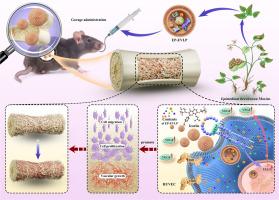淫羊藿。来源的细胞外囊泡样颗粒刺激vegf介导的血管生成以减轻绝经后骨质疏松症
IF 8.3
1区 医学
Q1 CHEMISTRY, MEDICINAL
引用次数: 0
摘要
绝经后骨质疏松症(PMOP)是一种导致脆性骨折的骨骼疾病,影响着数百万绝经后妇女。淫羊藿。EP具有抗骨质疏松的潜力,但其有效成分和机制尚不清楚。淫羊藿。衍生的细胞外囊泡样颗粒(ep - evlp)是天然存在的生物活性成分。迄今为止,尚未有研究全面探讨ep - evlp在ppu中的双重调控作用。目的探讨ep - evlp对ppu的骨靶向能力及治疗效果。方法采用差动超离心分离鲜EP叶sep - evlps,采用透射电镜、纳米颗粒跟踪分析、SDS-PAGE、琼脂糖凝胶电泳、薄层色谱和高效液相色谱等方法对其进行系统表征。体内研究评估了PMOP模型的骨靶向特异性、抗骨质疏松活性和生物相容性。体外分析包括:1)通过免疫组化染色和RT-qPCR评估hBMSCs和MC3T3细胞的成骨分化;2) CCK-8和流式细胞术检测HUVEC的增殖和凋亡;3)利用生物信息学分析、伤口愈合、跨井迁移、血管形成试验和ELISA评价血管生成潜力。结果从短淫羊藿中分离到sep - evlp。以杯状双层纳米颗粒的形式,含有核酸、蛋白质、脂质、epimedin C和关键的抗骨质疏松化合物(淫羊藿苷)。体内实验表明,它们在骨质疏松的股骨中优先积累,有效减轻骨质流失,无肝肾毒性。在机制上,ep - evlp剂量依赖性地上调VEGF表达,增强HUVEC的增殖、迁移和管的形成。这种血管生成驱动的骨血管生态位重塑与骨稳态恢复相关。结论ep - evlp通过淫羊藿素介导的vegf驱动的血管生成激活来挽救绝经后骨质疏松症。这种植物来源的纳米平台通过血管重建耦合成骨来恢复骨稳态,建立了一种具有翻译前景的靶向治疗策略。本文章由计算机程序翻译,如有差异,请以英文原文为准。

Epimedium brevicornu Maxim.-derived extracellular vesicle-like particles stimulate VEGF-mediated angiogenesis to alleviate postmenopausal osteoporosis
Background
Postmenopausal osteoporosis (PMOP), a bone disease causing fragility fractures, affects millions of postmenopausal women. Epimedium brevicornu Maxim.(EP) shows anti-osteoporotic potential, but its active components and mechanisms remain unclear. Epimedium brevicornu Maxim.-derived extracellular vesicle-like particles (EP-EVLPs) are naturally occurring bioactive constituents. To date, no studies have comprehensively addressed the dual regulatory role of EP-EVLPs in PMOP.
Purpose
To investigate the bone-targeting capability and therapeutic efficacy of EP-EVLPs against PMOP.
Methods
EP-EVLPs were isolated from fresh EP leaves via differential ultracentrifugation and systematically characterized using transmission electron microscopy, nanoparticle tracking analysis, SDS-PAGE, agarose gel electrophoresis, thin-layer chromatography, and high-performance liquid chromatography. In vivo studies evaluated bone-targeting specificity, anti-osteoporotic activity, and biocompatibility in PMOP models. In vitro analyses included: 1) Osteogenic differentiation assessment of hBMSCs and MC3T3 cells through immunohistochemical staining and RT-qPCR; 2) HUVEC proliferation and apoptosis assays via CCK-8 and flow cytometry; 3) Angiogenic potential evaluation using bioinformatic analysis, wound healing, transwell migration, tube formation assays and ELISA.
Results
EP-EVLPs were isolated from Epimedium brevicornu Maxim. in the form of cup-shaped, bilayer nanoparticles, containing nucleic acids, proteins, lipids, epimedin C, and key anti-osteoporotic compounds (icariin). In vivo experiments revealed their preferential accumulation in osteoporotic femora, effectively mitigating bone loss without hepatorenal toxicity. Mechanistically, EP-EVLPs dose-dependently upregulated VEGF expression, enhancing HUVEC proliferation, migration, and tube formation. This angiogenesis-driven remodeling of the osseous vascular niche correlated with restored bone homeostasis.
Conclusion
We identify EP-EVLPs rescue postmenopausal osteoporosis through icariin-mediated activation of VEGF-driven angiogenesis. This plant-derived nano-platform restores bone homeostasis by revascularization-coupled osteogenesis, establishing a targeted therapeutic strategy with translational promise.
求助全文
通过发布文献求助,成功后即可免费获取论文全文。
去求助
来源期刊

Phytomedicine
医学-药学
CiteScore
10.30
自引率
5.10%
发文量
670
审稿时长
91 days
期刊介绍:
Phytomedicine is a therapy-oriented journal that publishes innovative studies on the efficacy, safety, quality, and mechanisms of action of specified plant extracts, phytopharmaceuticals, and their isolated constituents. This includes clinical, pharmacological, pharmacokinetic, and toxicological studies of herbal medicinal products, preparations, and purified compounds with defined and consistent quality, ensuring reproducible pharmacological activity. Founded in 1994, Phytomedicine aims to focus and stimulate research in this field and establish internationally accepted scientific standards for pharmacological studies, proof of clinical efficacy, and safety of phytomedicines.
 求助内容:
求助内容: 应助结果提醒方式:
应助结果提醒方式:


